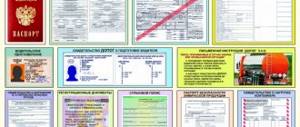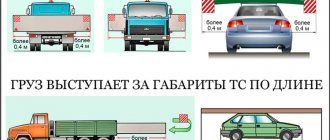Different types of activities are closely related to the implementation of a set of rules and restrictions. This is necessary for safe interaction with the population and nature of the planet. In the field of cargo transportation, it is no less carefully required to comply with the established framework, especially if the transported cargo is classified as dangerous, and its movement is associated with the risk of causing environmental harm. The presence of a special document - a certificate for the transportation of dangerous goods (ADR) helps to minimize the likelihood of the consequences of transporting hazardous goods. How the registration and receipt of ADR occurs, as well as what subtleties of the process exist, we will consider in this article.
General information about ADR
The International Agreement for the Carriage of Dangerous Goods by Road (abbreviation ADR) by road was drawn up and signed in 1957 in the city of Geneva. The Treaty prescribes the specifics of design, packaging, as well as the movement of harmful products and substances of various types of danger on the roads. The agreement is still in force and must be strictly observed in the following states:
- European Union;
- Russia;
- Morocco;
- Azerbaijan;
- those planning to join the European Union.
All countries participating in the harmonization have the right to adjust the requirements of ADR in accordance with domestic legislation. Accordingly, when planning to cross the border during a trip, it would be a good idea to clarify and take into account the adjustments regarding ADR in the destination country.
Structure of ADR
The agreement consists of two appendices – “A” and “B”, which consist of 9 detailed parts.
The first appendix (part A) contains a general set of rules and suggestions that affect the characteristics of the hazardous substances themselves :
- The first covers general provisions.
- The second describes the classification of substances.
- The third provides a list of all dangerous goods, as well as some special restriction provisions.
- The fourth section presents the requirements for containers that can be used for a particular cargo.
- The fifth part describes the stages of the transportation registration procedure.
- The sixth is a list of requirements for the quality and testing of containers and tanks for the transport of dangerous goods.
- The seventh part describes in detail the requirements for the conditions of transportation, loading and shipment of dangerous goods, as well as the conditions for reception and processing.
The remaining parts are reserved for Appendix “B”, which discusses the basic requirements for transport operations and equipment:
- Requirements for drivers and crew who will accompany the cargo, as well as a description of the characteristics of vehicles that are allowed to transport one or another type of dangerous goods, a description of documents (samples of what should be in them).
- Requirements for transport design.
Violation of ADR rules threatens the customer and the contractor with significant fines.
Types of hazards
According to ADR, all hazards can be divided into several categories:
- Oxidation (causes fire).
- Explosion hazard.
- Fire hazard.
- Causticity, or corrosivity.
- Toxicity, or toxicity.
- Radioactivity.
Structure
The document permitting the transportation of harmful substances on the roads of the participating countries used to look like a booklet indicating current information about the driver, the vehicle and the cargo being transported. The modern certificate is a compact plastic card. Driver information and information about hazardous substances permitted for a specific vehicle to be transported are displayed on the sides of the certificate.
The ADR permit is composed of two chapters, which are divided into smaller sections. The first chapter (block A) contains information about products that are classified as malicious, as well as requirements for loading, unloading, escort and transportation.
- Basic provisions.
- Classification. Generally accepted register of dangerous goods.
- Criteria for testing containers for packaging harmful elements.
- Instructions for the container used.
- Standards for transporting unsafe products.
- Travel conditions at each stage of the journey.
- Procedure for registration and receipt.
The second part (block B) contains information about the vehicles used, as well as additional equipment.
- Employee certification standards that relate to loading/unloading/transportation of hazardous materials (dangerous goods).
- Listing of documentation required to perform flights.
- Criteria for vehicles.
- Regulations on the labeling of transported hazardous substances.
Based on the approved requirements, the personnel of the company involved in the transportation, storage or disposal of hazardous products will need to undergo training and obtain a license to work with exhaust gases.
Obtaining an ADR certificate in 2 working days
Transporting dangerous goods involves risks. Inattention to transportation can cause fires, explosions, and also cause damage to material assets, the environment, life, and health of people and animals. It is clear that when organizing such events, the safety of the goods and the safety of its transportation are very important. These tasks are effectively solved by specialists involved in loading, unloading and further delivery of cargo to its destination. Such cargo and its movements are handled by carriers who have the necessary permits for the vehicle and the driver’s permits.
ADR for drivers
If you are a customer and want to entrust the delivery of dangerous goods from one point to another, you should know what the driver’s ADR is and that those carriers to whom you entrust such a task are required to have this document. So, ADR is a special certificate of approval for transportation of substances that pose a threat to the environment. This is an international document, drawn up taking into account all the features of dangerous goods. It is obtained after training and passing an exam. Drivers study according to a special program approved by the Ministry of Transport of the Russian Federation.
The document is issued for five years. It contains 2 columns: in tanks/except for tanks. Only those classes in which drivers have successfully passed the exam are open; the remaining classes in all columns must be crossed out. ADR also regulates the following concepts:
- containers recommended for the transportation of cargo of various classes;
- packaging labeling;
- specific requirements for the transport used for transportation.
In general, ADR exists to facilitate the procedure for registration and transportation of goods classified as unsafe.
All drivers working in such cargo transportation undergo basic courses. After completing training, drivers must pass exams at the State Traffic Inspectorate of the Ministry of Internal Affairs of the DPR. This exam consists of 25 test tasks, you are allowed to make mistakes in three of them. After this, the driver receives an ADR certificate.
Drivers and cargo owners must have a good knowledge of the rules for working with such cargo. Such operations bring high income. Therefore, both parties involved in the cargo delivery process must control all its stages. Violation of the rules can lead to the imposition of high fines from the customer and the contractor.
Hazard classes
The international procedure for the classification of hazardous substances is in effect on the territory of the Russian Federation.
Detailed ranking is indicated in the corresponding GOST - 19433. 9 hazard classes were studied:
- Explosive products.
- Gases: under pressure, liquefied and compressed.
- Flammable liquids.
- Flammable and toxic solid materials.
- Peroxides and oxidizing agents.
- Materials with infectious properties.
- Radioactive elements.
- Corrosive substances
- Other elements that pose a danger to the environment.
The transported hazardous substances are marked in the approved colors:
- colorful shades of red and green indicate explosive elements;
- Light shades of yellow and white mark radioactive and caustic cargo.
Training and cost
To obtain an ADR permit at an early stage, it was enough to make a payment, attend a short lecture and pass a certification after it. However, compulsory courses were introduced in 2013 in order to improve the quality of training.
Courses are conducted in specialized educational institutions approved by Rostransnadzor. Based on the lectures listened to, they give certification marks. The training scheme was approved by Decree of the Ministry of Transport of the Russian Federation No. 273 dated September 21, 2016.
Accreditation of an educational institution is required!
List of available training courses:
- Required. Introduces the hazard classes of cargo, the nuances of trip planning, requirements for a vehicle and other equipment. Drivers study measures to prevent and eliminate unusual situations on the road. After certification, access to transportation of exhaust gases opens, except for radioactive and explosive products in tanks.
- Optional course No.1. Provides information on the rules and specifics of transporting harmful substances in road tanks. Loading and unloading is considered in detail, taking into account the moving features of the cylinder. Successful certification of a vehicle driver opens up the opportunity to obtain an ADR license for a fuel truck.
- Specialized course No2. The training is entirely based on the standards and features of transporting explosive cargo: what kind of transport container should be, what standards are required in the vehicle, etc. The possibility of combined transportation with other substances must be considered.
- Additional course No3. Studies and considers the characteristic properties of radioactive materials and products, requirements for the transport containers used, methods of personal protection, as well as the need for additional equipment.
It will take about 5 days to submit an application for training, pay and issue a certificate. For international transportation, the ADR permit document is duplicated not only in Russian, but also in English, German or French.
The final cost of training directly depends on:
- type of training (initial or recertification);
- focus of the training course;
- number of lectures attended;
- regional location.
There are known cases where training was conducted in an institution with invalid accreditation. The validity of the accreditation of the selected institution can be easily checked on the Rostransnadzor website. If accreditation is absent or in doubt, the certificates obtained will be considered invalid. And the use of false documentation entails monetary penalties and criminal penalties.
In exceptional situations, it is possible to expressly take one course required specifically for the upcoming trip.
If you suddenly need additional verification of authenticity, just fill out an application on the website of the Ministry of Transport of the Russian Federation. Also in the public domain there is order No. 202 dated 07/09/2012.
Documentation
To receive the coveted card in plastic or laminated form, you will need to provide the following official papers to the controlling organization:
- Certificate - confirmation of completed training courses (original)
- Receipt for payment of tuition (invoice or payment details).
- Russian passport (original and copy). The presence of a foreign citizen on the territory of Russia under legal conditions requires the provision of an identity document. You will also need papers officially confirming the right to reside and engage in activities within the Russian Federation.
- An original and a double copy of a driver’s license, which must already have the category required for the transportation of dangerous goods. If the column with the required category is not open, then the driver will need to undergo training at a driving school on a general basis.
- The driver from the organization (legal entity) uses a special sample form for legal entities for the application.
- The driver, as an individual, fills out the application on his own.
In addition to the documentation provided, the applicant driver must meet the age criteria and also have at least 3 years of driving experience.
What the cost of studying?
At the moment, finding a place where such classes are held is not a problem. Without exception, all organizations of this kind issue certificates that are valid for 60 months. The price for taking courses for 2021 is 15,000 rubles.
Having considered what constitutes a permit for the transport of dangerous goods, one point should be noted. If the driver does not have this document during a trip with dangerous cargo, not only he, but also his employer may be held liable.
If you find an error, please select a piece of text and press Ctrl+Enter.
Didn't find the answer to your question? Find out how to solve exactly your problem - fill out the form below or call right now: +7 (ext. 697) (Moscow) +7 (ext. 281) (St. Petersburg) +8 (ext. 198) (Russia) It's fast and free!
Conditions of receipt
Despite mandatory training, registration and issuance of an ADR card is required for both the driver of the vehicle and the vehicle itself. The certificate indicates those hazard classes of hazardous cargo (explosive, corrosive, radioactive) that the specifically declared vehicle is allowed to transport.
If the vehicle is hired or leased, then it is necessary to provide a power of attorney for the right to drive along with the rental agreement.
To obtain a certificate for a car at the State Traffic Safety Inspectorate, you will need to meet certain requirements:
- the vehicle must be in technically sound condition and ready for work;
- vehicles were marked with danger signs in accordance with the classes of hazardous substances permitted for transportation;
- the additional equipment used is in working order and securely fastened;
- The vehicle was equipped with personal protective equipment (depending on the hazard class of the cargo being transported).
The issuance of an ADR certificate for the driver and vehicle is an immutable criterion for the transportation of harmful substances in Russia and abroad. In the absence of permitting documentation, the driver and the owner of the carrier company face significant fines, as well as a high risk of criminal punishment.










